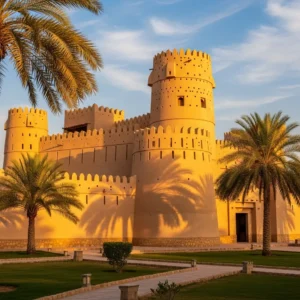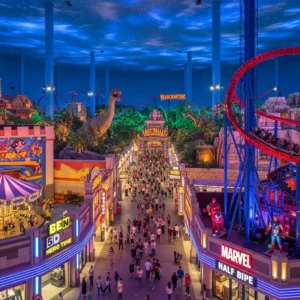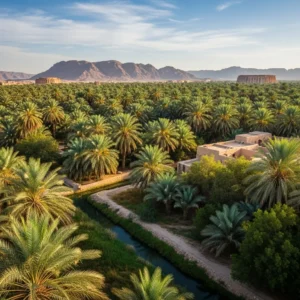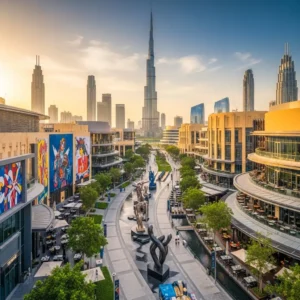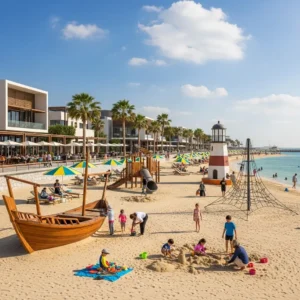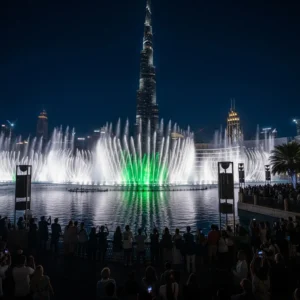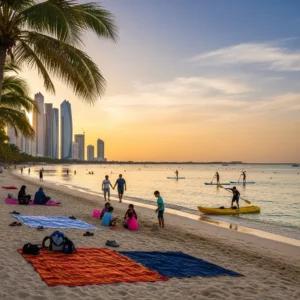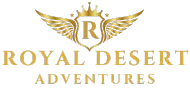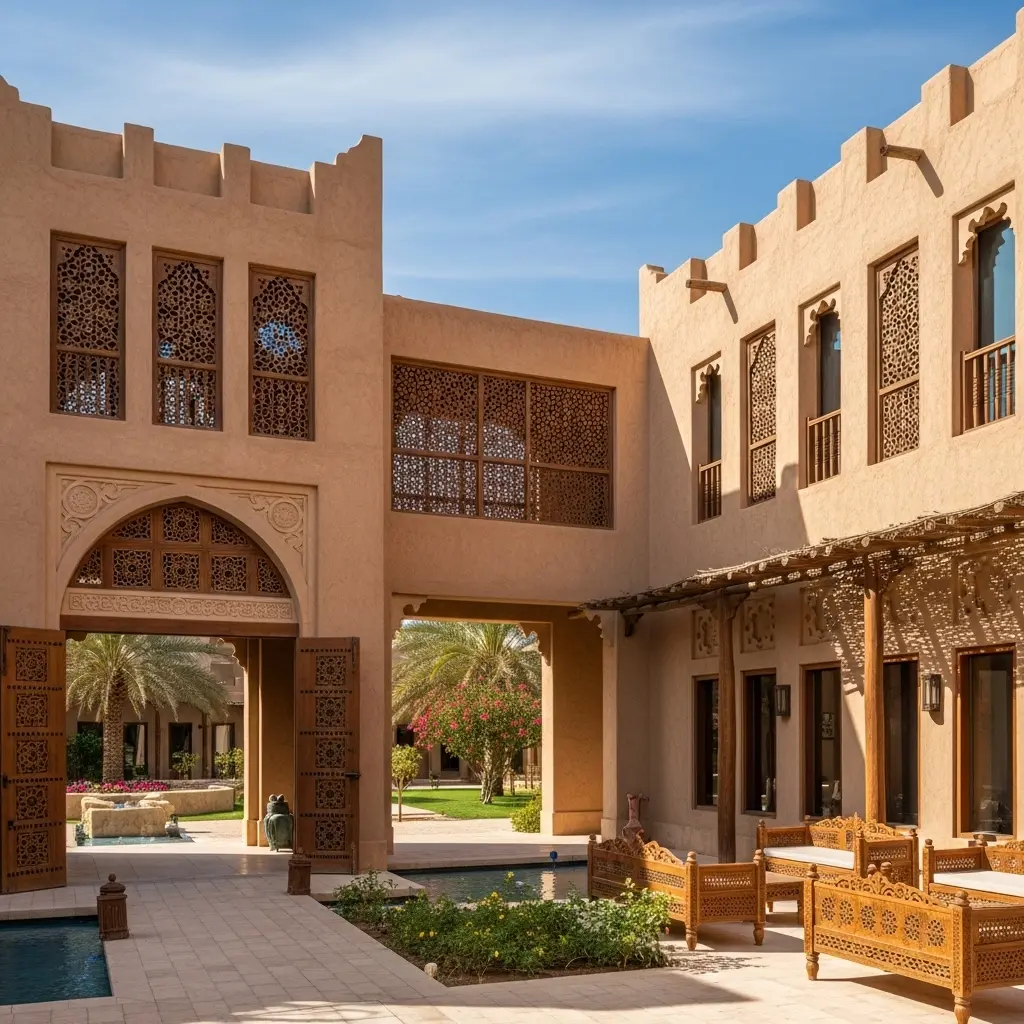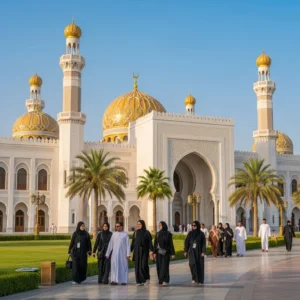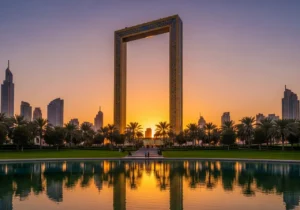The Heart of Heritage: A Deep Dive into Al Qattara Arts Centre
In the heart of Al Ain, the lush “Garden City” of the Abu Dhabi emirate, lies a destination where history and creativity converge in a beautiful dialogue. The Al Qattara Arts Centre is a remarkable institution housed within a restored historic fort, a place that serves as both a guardian of Emirati heritage and a vibrant incubator for contemporary artistic talent.
Far from the bustling tourist hubs, a visit to the Al Qattara Arts Centre offers a serene and deeply enriching cultural experience. It is a place to connect with the artistic soul of the UAE, to witness ancient traditions being passed down to new generations, and to see the modern art scene of the nation flourish. This in-depth guide will explore the fascinating history, stunning architecture, and diverse creative offerings of this unique cultural gem. An excursion here provides a peaceful contrast to more adventurous Emirati experiences, like those offered at https://royaldesertadventures.ae/.
From Fortress to Fine Arts: The History of Al Qattara
To truly appreciate the Al Qattara Arts Centre, one must first understand the rich history of the ground upon which it stands. The centre is built around the historic Al Qattara Fort, a structure that has watched over the surrounding oasis for generations.
The Origins of Al Qattara Fort
The fort is intrinsically linked to the Al Nahyan ruling family. Its history traces back to the Bani Yas tribe who settled in the region, drawn by the life-giving waters of the oases. The original structure, with its imposing watchtower, served a vital purpose: to protect the precious date palm gardens of the Al Qattara Oasis from outside threats. It stood as a symbol of community, a safe haven, and a testament to the resilience of the people who made their home in the desert landscape.
The Visionary Restoration Project
For many years, the fort lay in disuse. However, with a deep commitment to preserving the nation’s heritage, the Abu Dhabi Authority for Culture & Heritage (ADACH) undertook a visionary restoration project. The goal was not simply to rebuild the fort but to give it a new, living purpose. The project, completed in 2011, masterfully transformed the historic site into a modern arts centre, ensuring that the legacy of Al Qattara would continue to enrich the community for decades to come. This transformation is what makes the Al Qattara Arts Centre so special.
The Architecture: A Dialogue Between Past and Present
The architectural approach to the Al Qattara Arts Centre is a masterclass in sensitive restoration. The design team successfully created a space that honors the original structure’s traditional Emirati character while seamlessly integrating the modern facilities required for a contemporary arts hub.
Preserving the Traditional Fort Structure
The restoration meticulously preserved the authentic features of the original mud-brick fort. As you walk through the complex, you are surrounded by the textures of the past. The thick, earthen walls, the traditional wooden doors, and the use of palm fronds (barasti) in the ceilings all speak to the heritage of the region. The central watchtower, the fort’s oldest feature, still stands proudly, offering a direct link to its historic purpose.
Integrating Modern Functionality
Woven into this historic fabric are clean, modern architectural elements. Sleek glass walls, steel beams, and state-of-the-art lighting systems have been introduced to create functional and inspiring spaces for art. This juxtaposition of old and new is deliberate and powerful. The glass walls of the new buildings reflect the ancient mud-brick of the old, creating a constant visual dialogue between the past and the present, perfectly mirroring the mission of the Al Qattara Arts Centre.
A Hub of Creativity: The Studios and Workshops
The true heartbeat of the Al Qattara Arts Centre is found in its dedicated art studios. These are active, working spaces where students of all ages and skill levels can learn traditional and contemporary art forms under the guidance of expert instructors.
The Pottery Studio: Shaping Clay and Culture
The Space and Equipment
The pottery studio is a bright and inspiring space, fully equipped with modern pottery wheels, tools, and a high-tech kiln for firing the finished pieces. The studio is designed to be a hands-on environment where creativity can take shape.
The Art Form
Pottery has been an essential craft in this region for thousands of years, with archaeological finds in Al Ain dating back centuries. The studio at the Al Qattara Arts Centre keeps this ancient tradition alive, teaching the techniques used to shape clay into both functional and decorative objects.
The Workshops
A range of workshops is offered, catering to everyone from young children taking their first pottery class to experienced adults looking to refine their skills. Students can learn everything from basic wheel-throwing techniques to advanced glazing and firing processes.
The Calligraphy Studio: The Art of Beautiful Writing
The Space and Tools
The calligraphy studio is a quiet and contemplative space, designed to foster the intense focus required for this disciplined art form. Students work with traditional tools, including the qalam (a pen made from dried reed) and specially prepared inks.
The Art Form
Arabic calligraphy is one of the highest art forms in Islamic culture, revered for its beauty and spiritual significance. The studio at the Al Qattara Arts Centre provides a vital link to this heritage, teaching various classical scripts such as Kufic, Naskh, and Thuluth.
The Workshops
Classes are available for all levels. Beginners learn the fundamentals of letterforms and posture, while more advanced students work on complex compositions and traditional presentation methods.
The Painting and Drawing Studio
Fostering Contemporary Talent
This spacious and well-lit studio is dedicated to the visual arts of painting and drawing. It serves as an incubator for the region’s emerging contemporary artists, providing them with the space and resources to develop their creative voices.
The Workshops
The Al Qattara Arts Centre offers a robust schedule of classes in various mediums, including oil painting, acrylics, watercolour, and charcoal drawing. The courses are structured for different age groups, with dedicated classes for children, teenagers, and adults.
The Music Studio: The Sounds of Heritage
Reflecting the importance of music in Emirati culture, the centre also includes a studio for traditional music. Here, students can learn to play iconic regional instruments like the Oud, a pear-shaped stringed instrument, and the Rubaba, a type of fiddle, ensuring that the nation’s musical heritage continues to resonate.
The Facilities: Supporting Art and Community
Beyond the studios, the Al Qattara Arts Centre is equipped with several other facilities that support its mission and serve the wider community.
The Qattara Gallery
The centrepiece of the modern extension is the Qattara Gallery. This is a professional, museum-standard exhibition space dedicated to showcasing the work of Emirati and UAE-based artists. The gallery hosts a rotating schedule of exhibitions throughout the year, ranging from solo shows by emerging artists to group exhibitions based on a specific theme. It provides a crucial platform for local talent to gain exposure and for the public to engage with the contemporary art scene of the UAE.
The Library and Research Centre
For those wishing to delve deeper, the centre houses a comprehensive library. Its collection is focused on art history, theory, and criticism, with a special emphasis on Arab and Islamic art. It serves as an invaluable resource for students, artists, and researchers.
The Café and Courtyard
At the heart of the Al Qattara Arts Centre is a beautiful open-air courtyard that connects the historic fort with the modern gallery. An on-site café offers a tranquil spot for artists and visitors to gather, discuss art, and enjoy the serene atmosphere of the oasis surroundings.
The Al Qattara Souq: A Marketplace of Tradition
Adjacent to the arts centre is the Al Qattara Souq, a traditional marketplace that primarily operates on weekends from October to May. A visit to the souq beautifully complements the experience of the arts centre, offering another glimpse into the region’s heritage. Here, you can find local artisans selling traditional handicrafts, local produce, and spices. It’s a wonderful way to experience local culture and find authentic souvenirs. Exploring such cultural sites can be a key part of a broader tour of the UAE, with travel insights available from resources like https://dubaidesertsafarie.com/.
Planning Your Visit to Al Qattara Arts Centre
A visit to this cultural hub is a rewarding experience, and a little planning can help you make the most of it. For more travel planning across the Emirates, you can consult resources like https://hafiztourism.com/.
Location, Timings, and Entry
The Al Qattara Arts Centre is located in the Garden City of Al Ain, which is about a 90-minute drive from both Dubai and Abu Dhabi.
- Timings: The centre is typically open from Saturday to Thursday, with morning and evening hours. It is usually closed on Fridays. It is always best to check the official Abu Dhabi Culture website for the most current opening times.
- Entry: Entry to the arts centre and its gallery is generally free of charge. Fees will apply for those wishing to enroll in one of the art workshops or courses.
How to Enroll in a Workshop
Information about the latest schedule of workshops and classes can be found on the official cultural websites or by contacting the Al Qattara Arts Centre directly. Registration is often required in advance, as class sizes can be limited to ensure quality instruction.
The Al Qattara Arts Centre is a testament to the UAE’s profound respect for its past and its confident investment in the future. It is a place where culture is not just displayed but is actively created, shared, and passed on. A visit offers a unique opportunity to step away from the beaten path and connect with the authentic creative spirit of the Emirates, making it a perfect cultural complement to an itinerary that might also include an adventure from https://royaldesertadventures.ae/.
Frequently Asked Questions (FAQs)
- Is there an entrance fee for Al Qattara Arts Centre? No, general admission to the Al Qattara Arts Centre, including access to the Qattara Gallery and the public areas, is typically free of charge. This makes it a wonderfully accessible cultural destination. Fees are only applicable if you wish to register for one of the specific art workshops or courses offered in the studios.
- Do I need to be an artist to visit the centre? Not at all. The centre is designed for everyone, from professional artists to curious tourists and local families. You can visit simply to admire the historic fort architecture, view the current exhibition in the art gallery, or enjoy the serene atmosphere in the courtyard cafe. It offers a rewarding experience for anyone interested in culture and heritage.
- What is the history of the Al Qattara Fort? The Al Qattara Fort is a historic mud-brick structure located in the Al Qattara Oasis of Al Ain. Its origins trace back several centuries, with its prominent watchtower serving as a key defensive structure to protect the vital oasis and its community. It is historically linked to the Al Nahyan family and is a tangible piece of the region’s pre-oil era heritage, representing the traditional way of life in the oases.
- Can my children take art classes at the centre? Yes, the Al Qattara Arts Centre has a strong focus on community education and offers a wide range of art workshops specifically designed for children and teenagers. These classes, which often include pottery, drawing, and painting, are a fantastic way for young people to engage with their creativity in a fun and inspiring environment.
- What is the best way to get to Al Ain from Dubai or Abu Dhabi? Al Ain is approximately a 90-minute drive from both Dubai and Abu Dhabi city. The most convenient way to travel is by car, and the motorways are excellent. There are also public bus services that run regularly from the main bus stations in Dubai and Abu Dhabi to Al Ain, which offer a very affordable option.
- Is the Al Qattara Arts Centre open during the summer? Yes, unlike some seasonal outdoor attractions, the Al Qattara Arts Centre is an indoor facility and typically remains open throughout the year, including the summer months. However, the adjacent Al Qattara Souq is usually seasonal and operates only during the cooler winter months. It’s always best to check the official website for any changes to summer timings.
- What is the Qattara Gallery? The Qattara Gallery is a modern, professional exhibition space located within the Al Qattara Arts Centre. Its primary mission is to support and promote the work of Emirati and UAE-based artists. It hosts a rotating series of exhibitions throughout the year, providing a vital platform for the local contemporary art scene.
- Can I buy art at the centre? While the centre’s primary focus is on education and exhibition, some of the artworks displayed in the Qattara Gallery by contemporary artists may be for sale. Inquiries about purchasing art would typically be handled by the gallery management or by contacting the artist directly.
- What languages are the art classes conducted in? The classes at the Al Qattara Arts Centre are typically conducted in both Arabic and English to cater to the diverse multinational community of the UAE. The instructors are usually bilingual, ensuring that all students can fully participate and benefit from the workshops.
- What is the Al Qattara Souq? The Al Qattara Souq is a traditional marketplace located next to the arts centre. It operates seasonally (usually on weekends from October to May) and is dedicated to promoting local heritage and handicrafts. It’s a great place to see traditional Emirati products and crafts, complementing the cultural experience of the arts centre.
- Are there any other historical sites near the centre? Yes, Al Ain is a UNESCO World Heritage site and is rich in history. Near the Al Qattara Arts Centre, you can visit other oases, the Al Ain Palace Museum, the Al Jahili Fort, and the Hili Archaeological Park, making it a fantastic area for a full day of cultural exploration.
- Is there a cafe or restaurant at the centre? Yes, there is a small, charming cafe located within the Al Qattara Arts Centre. It is situated in the main courtyard and offers a peaceful setting to enjoy a coffee or a light snack before or after you explore the galleries and studios.
- How is the new building integrated with the old fort? The architecture masterfully blends the old and new. The original fort’s mud-brick structure and watchtower are preserved, while a new building housing the gallery and library was built with modern materials like glass and steel. The new structure is designed to complement, not overshadow, the old fort, with glass walls that reflect the historic facade, creating a visual connection between past and present.
- What kind of traditional music can I learn about? The music studio at the Al Qattara Arts Centre focuses on teaching traditional Emirati and Arabic music. The primary instrument taught is the Oud, a pear-shaped, fretless string instrument that is central to Arabic music. Other regional instruments may also be featured in workshops.
- Are the art classes expensive? The workshops at the Al Qattara Arts Centre are heavily supported by the government’s cultural foundation, making them very affordable and accessible to the general public. The goal is to encourage community participation in the arts, so the fees are kept reasonable compared to private art schools.
- How large is the centre? The Al Qattara Arts Centre is an intimate and focused facility. While not massive in scale, it is comprehensive in its offerings, with several dedicated studios for different art forms, a professional gallery, a library, and a theatre, all thoughtfully arranged within the historic fort complex.
- Do I need to bring my own art supplies for a workshop? Generally, for most introductory workshops, the basic materials and supplies are provided by the Al Qattara Arts Centre and are included in the course fee. For more advanced or specialized courses, students may be required to purchase some of their own supplies, such as specific paints or canvases. This would be communicated upon registration.
- Is photography allowed inside the centre? Yes, photography for personal use is generally permitted in the public areas of the Al Qattara Arts Centre, including the courtyard and exterior of the fort. However, photography inside the Qattara Gallery may be restricted depending on the specific exhibition and the artists’ requests. It is always best to check for signage or ask the staff for permission before taking photos of the artworks.
- Who runs and manages the Al Qattara Arts Centre? The centre was developed by and is managed under the umbrella of the Department of Culture and Tourism – Abu Dhabi (DCT Abu Dhabi). This governmental body is responsible for preserving and promoting the heritage and culture of the emirate, and the centre is a key part of its strategy to foster the arts in the Al Ain region.
- Is the centre more focused on traditional or contemporary art? The beauty of the Al Qattara Arts Centre is that it is equally focused on both. The workshops in pottery and calligraphy are dedicated to preserving traditional heritage crafts. Simultaneously, the painting and drawing studios and the Qattara Gallery provide a vibrant platform for the development and exhibition of modern and contemporary art, making it a true bridge between the UAE’s artistic past and its creative future.
